Into a New Millennium 1970 - 2000














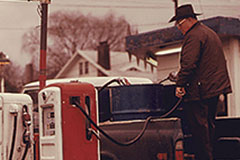



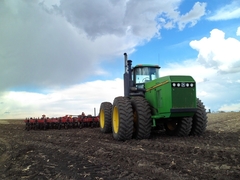










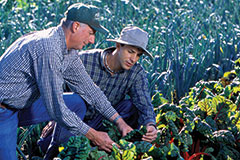




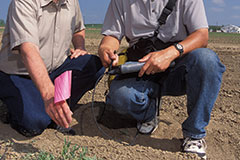


















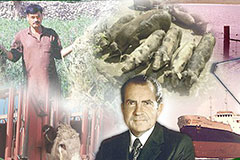




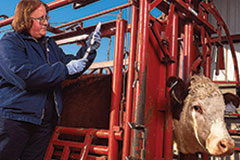



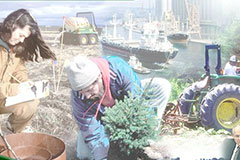


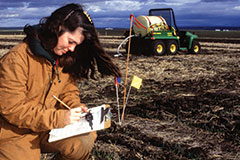

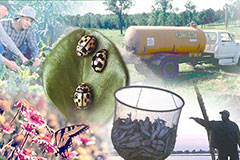












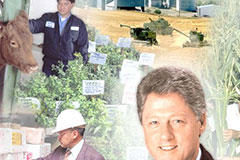





What would you like to find?

Downloadable Media: Into a New Millennium
Imagery













Video
Audio





































Farmers made up only 4.6 percent of the American workforce in the early 1970s, yet this tiny minority generated nineteen percent of the United States' exports. At the same time they fed an unprecedented average of forty-eight people per farmer, many of those outside the United States. It was what American farmers had been striving for - a period of growth and prosperity.
The Soviet Union, (then the world's largest nation) along with various smaller countries in the communist bloc, opened their borders in 1970 to agricultural trade with the United States. In 1972, the Soviet Union experienced a major wheat crop failure. During this time additional crop failures outside of North America spurred massive foreign buying of American grain. Commodity prices soared, and farmers prospered. Farmers were encouraged to expand and increase production to take advantage of the booming market. Farmers took out loans, bought land and invested in cutting-edge technologies such as innovative irrigation systems, specialized and more efficient farm machinery, and new pesticides and herbicides. Flourishing foreign trade with the Soviet bloc enlarged the export market for agriculture, and American farmers reaped robust profits.
How long would this new cycle of prosperity last? How would American agriculture adapt to the challenges of a global economy? How would American agriculture adapt to an increasingly complex and technological world transitioning into a new era in history? Consider these and other questions as you explore, "Growing A Nation: Into A New Millennium."
Exports of agricultural products increased drastically in the decade of 1990-2000 based on the economic recovery of the Asian financial crisis and the strengthening of other global trading partners.

Exports 1970-1990s
From 1970-1979, the average annual value of agricultural exports totaled $19.8 billion/year or 19% of total exports.
From 1980-1989, the average annual value of agricultural exports totaled $35.6 billion/year or 15% of total exports.
From 1990-1999, the average annual value of agricultural exports totaled $48.5 billion/year or 10% of total exports.
Questions
What underlying factors contributed to the data? Explain.
In the 1970s the average total U.S. population: 204,335,000; farm population: 9,712,000; farmers 4.6% of labor force; number of farms: 2,780,000; average acres farmed: 390. It takes 2-3 labor-hours required to produce 100 pounds (1/5 acre) of lint cotton with tractor, 2-row stalk cutter, 20-foot disk, 4-row bedder and planter, 4-row cultivator with herbicide applicator, and 2-row harvester; 3-3/4 labor-hours required to produce 100 bushels (3 acres) of wheat with tractor, 30-foot sweep disk, 27-foot drill, 22-foot self-propelled combine, and trucks; 3-1/3 labor-hours required to produce 100 bushels (1 1/8 acres) of corn with tractor, 5-bottom plow, 20-foot tandem disk, planter, 20-foot herbicide applicator, 12-foot self-propelled combine, and trucks (1975). One farmer supplies food and fiber for 47.7 people.
In the 1980s the average total U.S. population: 227,020,000; farm population: 6,051,000; farmers 3.4% of labor force; number of farms: 2,439,510; average acres: 426; irrigated acres: 50,350,000. It takes 1-1/2 to 2 labor-hours required to produce 100 pounds (1/5 acre) of lint cotton with tractor, 4-row stalk cutter, 20-foot disk, 6-row bedder and planter, 6-row cultivator with herbicide applicator, and 4-row harvester; 3 labor-hours required to produce 100 bushels (3 acres) of wheat with tractor, 35-foot sweep disk, 30-foot drill, 25-foot self-propelled combine, and trucks; 2-3/4 labor-hours required to produce 100 bushels (1 1/8 acres) of corn with tractor, 5-bottom plow, 20-foot tandem disk, planter, 20-foot herbicide applicator, 12-foot self-propelled combine, and trucks (1987). One farmer supplies food and fiber for 75.7 people.
In the 1990s the average total U.S. population: 261,423,000; farm population: 2,987,552; farmers 2.6% of labor force; number of farms: 2,143,150; average acres: 461; irrigated acres: 49,404,000 (1992); number of farms: 2,215,876; average acres: 431; irrigated acres 56,289,172 (1997). One farmer supplies food and fiber for 100 people.
During this period of rapid population growth how do fewer farmers continue to feed a growing population both in the U.S. and abroad?
Farmers made up only 4.6 percent of the American workforce in the early 1970s, yet this tiny minority generated nineteen percent of the United States’ exports. At the same time they fed an unprecedented average of forty-eight people per farmer, many of those outside the United States. It was what American farmers had been striving for—a period of growth and prosperity. The total farm output of the United States had increased by more than fifty-two percent since World War II, with six percent fewer acres of land in production and sixty percent fewer hours of labor required. Farmers made up less than five percent of the United States labor force, yet they fed the rest of the nation and many of the people of the world.


Rise and Decline of Farms
This graph shows the rise and eventual decline in the number of farms in America.
Iowa Public Television also has a video about farms and farm production in the 1970s.
The 1970s See Good Times in Agriculture
Questions
Why do you think the number of farms has been declining?
What is happening to America's farms?
How might life in America change as the number of farms continues to decline?
History of American Agriculture, 1607-2000, U.S. Department of Agriculture [online].

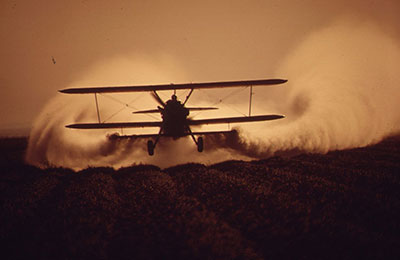
New Pesticides and Herbicides
Farmers readily adopted new pesticides and herbicides that were developed in the 1970s, which allowed them to capitalize on increased foreign trade with the Soviet Union.
Questions
What purpose do pesticides serve? Herbicides?
Why do researchers continue to develop and improve these products today?
Can you think of any specific pesticides or herbicides that are used in your area?

Agricultural Success
The success of U.S. agriculture cannot be attributed to fertile soil and ideal growing conditions alone. Financial resources from the government are also vital to the achievements of American agriculture. Research funding, financial aid during poor growth seasons, and education programs are just a few of many examples that have led American farming to agricultural success.
Questions
How do government resources contribute to your success as a student? Why are they provided?
Why does the government esteem research and education so highly?
What other factors do you think have contributed to U.S. agricultural development?

Fertile Soil
Fertile soil is one of the most valuable resources America possesses. Thus, soil conservation is a high priority for the USDA. Visit the Natural Resource Conservation Service website to learn more about this priceless natural resource.
Questions
Respecting and protecting environmental resources is one of the most valuable things we can do. What are some instances of environmental abuse during your lifetime?
What are some instances of environmental abuse that you are aware of from the past?

Environmental Laws and Regulations
Since President Nixon established the United States Environmental Protection Agency (EPA) in 1970, Congress has passed dozens of laws that the EPA enforces to protect the environment. Visit the EPA website to help you answer these questions.
Questions
What are the three steps to create these laws?
How is a regulation different from a law?
How many of these environmental laws affect agriculture?


Get Big or Get Out
Earl Butz became the Secretary of Agriculture (1971-1976) as food prices climbed high enough to generate political heat. He abolished a USDA program that paid corn farmers to not plant all their land. This program had unsuccessfully attempted to prevent a national oversupply of corn and low corn prices. His mantra to farmers was "get big or get out", and he urged farmers to plant commodity crops such as wheat, corn, and soybeans "from fencerow to fencerow." Butz worked closely with agribusiness firms. Some considered this the begining of agricultural industirialization. His critics also noted that he was a director of three large agribusiness corporations. Some said his policies led to " the rise of major agribusiness corporations, and the declining financial stability of the small family farm."
"In 1972, the Soviet Union, suffering disastrous harvests, purchased 30 million tons of American grain. Butz had helped to arrange that sale in the hope of giving a boost to crop prices to bring restive farmers tempted to vote for George McGovern into the Republican fold.
He was featured in the documentary King Corn, recognized as the person who started the rise of corn production, large commercial farms, and the abundance of corn in American diets. In King Corn, Butz argued that the corn subsidy had dramatically reduced the cost of food for all Americans by improving the efficiency of farming techniques. By artificially increasing demand for food, food production became more efficient and drove down the cost of food for everyone."
Questions
During this time agricultural scientists developed higher yielding seed, easier to use fertilizer, and pesticides. Engineers designed more efficient machinery. This allowed for greater production with greater efficiencies. Iowa Public Television created a video about farms in the 1970s.
The 1970s See Good Times in Agriculture
What were some of unintended consequences of removing price supports, and increasing productivity?
https://en.wikipedia.org/wiki/Earl_Butz https://www.nytimes.com/1976/06/13/archives/why-they-love-earl-butz-prosperous-farmers-see-him-as-the-greatest.html
Following the four year farm bill in 1965, the next farm bill to be passed by Congress was the Agricultural Act of 1970 followed by the Agricultural and Consumer Protection Act of 1973, and the Food and Agricultural Act of 1977. As you explore these farm bills, find the similarities and difference between the different laws during this time period and/or how these bills compare to past farm bills passed by Congress.

The Agricultural Act of 1970
The Agriculture Act of 1970 (HR 18546-PL 91-524) was signed into law by President Nixon on November 30th after 16 months of making its way through the legislative branch. This bill caused a major controversy among farm groups, Congress, and the administration. The administration wanted to end parity or equality guarantees for price supports and replace it with flexible supports based on the world market prices. On the other hand, farm groups wanted higher parity guarantees because they believed farm income would be lowered by the administration’s plan.
Another point of contention in the 1970 farm bill came when looking at subsidies for farmers. Members of Congress representing urban areas had worked to end subsidies since 1968 because they wanted to end the program that had paid individual farmers and farms $4 million in one year. After debate surrounding subsidies the farm bill included a $55,000 ceiling on subsidies.
Questions
What would the advantages and disadvantages be for farmers and the government to have parity guarantees replaced by flexible supports based off of world markets?
Why might Congressional leaders representing urban populations want to limit the subsidies that farmers were given?
1970 Agricultural Act Cleared After 16-Month Debate. (1971). In CQ Almanac 1970, 26th ed., 01-634-01-644. Washington, DC: Congressional Quarterly.

The Agriculture and Consumer Protections Act of 1973
The Agricultural and Consumer Protection Act of 1973 (H.R.8860) was passed by the 93rd Congress. This law limits payments for commodities to $20,000. This law also included provisions and guidance for many areas of agriculture including milk, butterfat, the dairy product pesticide indemnity program, dairy imports, the wheat set-aside program, set aside programs for crops of feed grain, set aside programs for cotton, maintains eligibility for food stamps, and additional provisions for food stamps.
For more information about the Agriculture and Consumer Protection Act of 1973 view the Summary of the Act.
Questions
How do the provisions and guidance within the Agriculture and Consumer Protection Act of 1973 reflect what is going on during this era?
H.R. 8860-Agriculture and Consumer Protection Act. (n.d.). Congress.gov.

The Food and Agriculture Act of 1977
According to the Wikipedia summary posted on the govtrack website, the Food and Agriculture Act of 1977 was an omnibus bill or a bill that combines diverse topics and is accepted in a single vote by the legislature. This farm bill was signed into law on September 29, 1977. Included in this farm bill were income supports and the establishment of a farmer-owned reserve for grain and a two-tier program for peanuts. Actions were also taken to permanently amend the Food Stamp Act of 1964 under Title XIII (the Food Stamp Act of 1977), this provision eliminated the purchase requirement and simplified eligibility requirements. Title XIV of the Food and Agriculture Act of 1977 created an act that established the National Agriculture Research, Extension, and Teaching Policy Act, as well as, established the U.S. Department of Agriculture (USDA) as the leading federal agency for agricultural research, extensions, and teaching programs.
Questions
Why might it be important to establish an entity or department that concentrates on agricultural research, extension, and teaching?
What are the goals and mission of the USDA?
How does the mission and the goals of the USDA impact farmers and ranchers in the U.S.?
S. 275 (95th): Food and Agriculture Act. (n.d.). govtrack.
The Soviet Union, (then the worlds largest nation) along with various smaller countries in the communist bloc, opened their borders in 1970 to agricultural trade with the United States. In 1972, the Soviet Union experienced a major wheat crop failure. During this time additional crop failures outside of North America spurred massive foreign buying of American grain. Commodity prices soared, and farmers prospered. Farmers were encouraged to expand and increase production to take advantage of the booming market. Farmers took out loans, bought land and invested in cutting-edge technologies such as innovative irrigation systems, specialized and more efficient farm machinery, and new pesticides and herbicides. Flourishing foreign trade with the Soviet bloc enlarged the export market for agriculture, and American farmers reaped robust profits.

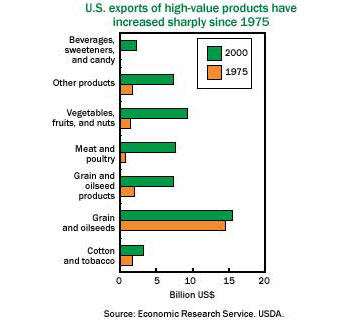
High-Value Product Exports
In the years between 1975 and 2000, agricultural exports rose sharply.
Questions
What foreign and domestic factors influence increases or decreases in exports?
How do politics play a part in the availability of food to starving nations?
What major imports do American consumers rely on?
Are these necessities, or are they products of choice and convenience?
Economic Research Service, U.S. Department of Agriculture [online].

History of Soviet Union
"Founded in the 12th century, the Principality of Muscovy was able to emerge from over 200 years of Mongol domination (13th-15th centuries) and to gradually conquer and absorb surrounding principalities. In the early 17th century, a new Romanov Dynasty continued this policy of expansion across Siberia to the Pacific. Under Peter I (ruled 1682-1725), hegemony was extended to the Baltic Sea and the country was renamed the Russian Empire. During the 19th century, more territorial acquisitions were made in Europe and Asia. Repeated devastating defeats of the Russian army in World War I led to widespread rioting in the major cities of the Russian Empire and to the overthrow in 1917 of the imperial household. The Communists under Vladimir Lenin seized power soon after and formed the USSR. The brutal rule of Josef Stalin (1928-53) strengthened Russian dominance of the Soviet Union at a cost of tens of millions of lives. The Soviet economy and society stagnated in the following decades until General Secretary Mikhail Gorbachev (1985-91) introduced glasnost (openness) and perestroika (restructuring) in an attempt to modernize Communism, but his initiatives inadvertently released forces that by December 1991 splintered the USSR into 15 independent republics. Since then, Russia has struggled in its efforts to build a democratic political system and market economy to replace the strict social, political, and economic controls of the Communist period."
Questions
How do you think the turmoil that the former Soviet Union has experienced, and is still experiencing, has affected its economy?
How would such disarray influence agricultural productivity?
The World Factbook, 2004, Central Intelligence Agency [online].


The energy crisis dominated world events during the 1970s. In October 1973, the Arab members of the Organization of Petroleum Exploring Countries (or OPEC) refused to ship oil to the United States, Western Europe or Japan in retaliation for their support of Israel during the Yom Kippur War against Egypt. The price of oil rose dramatically, triggering a worldwide energy crisis and economic recession. The Western world, especially the United States, had long taken energy for granted. Now there were shortages, rationing and long lines to purchase gasoline. The Federal Government imposed a nationwide speed limit of fifty-five miles per hour, created a strategic petroleum reserve and formed the Department of Energy. The energy crisis also affected farmers because modern agriculture depended heavily on petroleum powered equipment and on fertilizers derived from petroleum. The energy crisis generated interest in developing renewable energy sources, including growing crops to produce fuel.
Higher energy costs caused crop and livestock prices to surge and remain elevated until nearly the end of the decade. Farm land values remained high and interest rates low, which encouraged many farmers to take out large loans for the purchase of land and machinery.
The energy crisis dominated world events during the 1970s. In October 1973, the Arab members of the Organization of Petroleum Exporting Countries (or OPEC) refused to ship oil to the United States, Western Europe or Japan in retaliation for their support of Israel during the Yom Kippur War against Egypt. The price of oil rose dramatically, triggering a worldwide energy crisis and economic recession. The Western world, especially the United States, had long taken energy for granted. Now there were shortages, rationing and long lines to purchase gasoline.

OPEC
The Organization of Petroleum Exporting Countries (OPEC) mission "is to coordinate and unify the petroleum policies of its Member Countries and ensure the stabilization of oil markets in order to secure an efficient, economic and regular supply of petroleum to consumers, a steady income to producers and a fair return on capital for those investing in the petroleum industry." Visit the OPEC website to learn about these countries and find out where they are located.
Questions
What purpose does membership with OPEC serve?
What would happen if one of the oil-exporting countries were to withdraw its membership from OPEC?
Are there any other countries that possess oil as a natural resource?
Why are they not members of OPEC?

High Oil Prices
High oil prices in the 1970s led to significant strides in harnessing natural resources for energy. Visit the Energy Information Administration's website to see a chronological history of oil prices since 1968, and then answer the following questions.
Questions
How can political turmoil lead to downfalls in one industry, allowing research and development to progress in other industries at the same time?
How do we see this pattern still happening today?
What industries do you predict will experience further expansion in your lifetime?
The energy crisis also affected farmers because modern agriculture depended heavily on petroleum-powered equipment and on fertilizers derived from natural gas. The energy crises generated interest in developing renewable energy sources, including growing crops to produce fuel. Higher energy costs caused crop and livestock prices to surge and remain elevated until nearly the end of the decade. Farm land values remained high and interest rates low, which encouraged many farmers to take out large loans for the purchase of land and machinery.

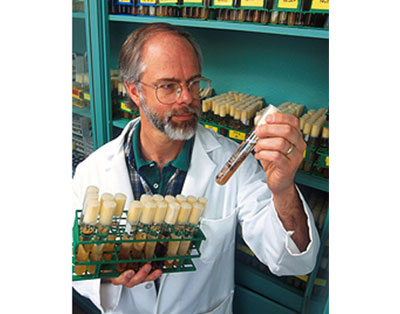
Plant Geneticists
Plant geneticists explore a plant's genes looking for those that control valuable traits, like tolerance to cold or the size or sweetness of its fruit. They also work to improve breeding methods and to ensure that future generations of a particular plant will have the traits farmers and consumers want.
Questions
How can plant gene research influence the size, taste, and color of certain crops?
What questions would you research if you were a plant geneticist?
Where would you start gathering information?
How did plant research help bolster American agriculture during the export boom of the early 1970s?

Renewable Energy Systems
"Renewable energy systems use resources that are constantly replaced and are usually less polluting. Examples of renewable energy systems include solar, wind, and geothermal energy (getting energy from the heat in the earth). We also get renewable energy from trees and plants, rivers, and even garbage.
"Renewable energy uses energy sources that are continually replenished by nature--the sun, the wind, water, the Earth's heat, and plants. Renewable energy technologies turn these fuels into usable forms of energy--most often electricity, but also heat, chemicals, or mechanical power. . . .
"Today we primarily use fossil fuels to heat and power our homes and fuel our cars. It's convenient to use coal, oil, and natural gas for meeting our energy needs, but we have a limited supply of these fuels on the Earth. We're using them much more rapidly than they are being created. Eventually, they will run out. And because of safety concerns and waste disposal problems, the United States will retire much of its nuclear capacity by 2020. In the meantime, the nation's energy needs are expected to grow by 33 percent during the next 20 years. Renewable energy can help fill the gap.
"Even if we had an unlimited supply of fossil fuels, using renewable energy is better for the environment. We often call renewable energy technologies 'clean' or 'green' because they produce few if any pollutants. Burning fossil fuels, however, sends greenhouse gases into the atmosphere, trapping the sun's heat and contributing to global warming. Climate scientists generally agree that the Earth's average temperature has risen in the past century. If this trend continues, sea levels will rise, and scientists predict that floods, heat waves, droughts, and other extreme weather conditions could occur more often.
"Other pollutants are released into the air, soil, and water when fossil fuels are burned. These pollutants take a dramatic toll on the environment--and on humans. Air pollution contributes to diseases like asthma. Acid rain from sulfur dioxide and nitrogen oxides harms plants and fish. Nitrogen oxides also contribute to smog.
"Renewable energy will also help us develop energy independence and security. The United States imports more than 50 percent of its oil, up from 34 percent in 1973. Replacing some of our petroleum with fuels made from plant matter, for example, could save money and strengthen our energy security."
Questions
Which of the renewable energy resources seem most viable to you?
What do you see as the major advantage of this resource? What are its disadvantages?
What do you think the United States should do to increase its use of renewable resources?
"Learning about Renewable Energy--For Young Scholars" and "Renewable Energy: An Overview," Office of Energy Efficiency and Renewable Energy, U.S. Department of Energy [online].

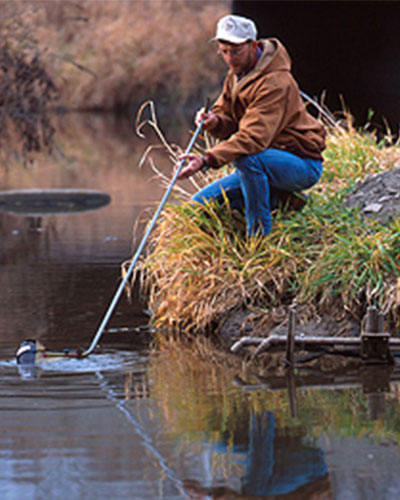
Hydrologists
"If you like discovering how soil and water create our environment, you may be interested in becoming a hydrologist or watershed specialist. Working with a variety of people, problem-solving, and application of some basic chemical concepts make this an interesting occupation. BLM [Bureau of Land Management] hydrologists/watershed specialists work at improving or maintaining water quality by recommending actions to minimize the effects of grazing, mining, logging, and other types of land uses. This involves developing an understanding of these land uses, developing long-term plans, and doing studies to ensure that the plans are successful. These specialists work with range conservationists, outdoor recreation planners, soil scientists, and others to help prepare plans for managing all the resources in a basin or watershed. These specialists must understand plants and soil, rocks and land features, water and weather. Sometimes they are called upon to recommend what kinds of grasses, shrubs, or trees to plant. They may design ponds or structures in streams to slow water and reduce erosion, or develop methods to study human uses of public land to determine if these uses are causing erosion and reducing plant cover for fish. High school courses that will help you prepare for a career as a hydrologist or watershed specialist include math, biology, physics, chemistry, computer science, speech, and English/writing courses. A bachelor's degree in a physical or natural science or engineering is required. Studies should include courses in hydrology, physical sciences, geophysics, chemistry, engineering science, soils, math, aquatic biology, geology, meteorology, oceanography, or the management or conservation of water resources."
Questions
What contributions do hydrologists make to our society?
How has the work of hydrologists impacted your life?
What aspects of preparation for a career in hydrology match the career preparation you need?
"Hydrologist," BLM Career Cards, Bureau of Land Management [online].


International trade doubled during the 1970s. Early in the decade President Nixon devalued the dollar, which made American products more affordable overseas. This, along with bad weather in competing agricultural nations around the world, increased the demand for American agricultural exports. By the end of the decade agriculture and the rest of the United States economy had become dependent on international trade. A global food and agricultural system was emerging which would greatly reduce food insecurity throughout the world, but would also put American farmers in direct competition with farmers in other countries.
Agricultural scientists increased the American farmer's competitive edge in this growing global marketplace with new research initiatives for small farms, solar energy, and energy conservation. They developed hundreds of improved varieties of fruits, vegetables, cotton, wheat and other crops (including carrot varieties with twice as much beta-carotene, an important nutrient).
Researchers made great strides in animal health. For example, agricultural scientists made important advances toward developing a vaccine for foot and mouth disease. Hog cholera was eliminated in 1978. This contagious disease of swine had killed enormous numbers of pigs for more than a century and cost pork producers tens of millions of dollars in losses each year.
International trade doubled during the 1970s. Early in the decade President Nixon devalued the dollar, which made American products more affordable overseas. This, along with bad weather in competing agricultural nations around the world, increased the demand for American agricultural exports. By the end of the decade agriculture and the rest of the United States economy had become dependent on international trade. A global food and agricultural system was emerging which would greatly reduce food insecurity throughout the world, but would also put American farmers in direct competition with farmers in other countries.

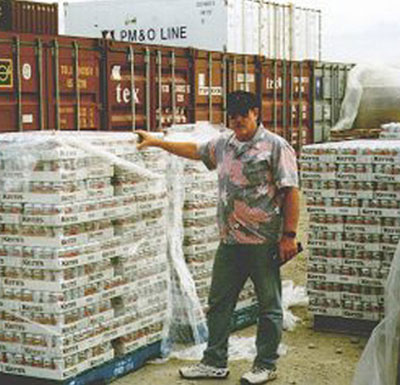
Feeding the World
The low value of the American dollar in the 1970s increased opportunities for agricultural exports. America's farmers could boast that they fed the world as the economy depended more and more on trade overseas.
Questions
Do America's farmers still feed the world today?
Do American agricultural exports still exceed its imports?
From what country does the majority of U.S. imports come today?

Panama Canal Neutrality
On September 7, 1977 President Jimmy Carter signed the Panama Canal Treaty that would turn control of the canal over to Panama in 1999 and guarantee the canal's neutrality. Take a time-lapse journey through the canal and answer the following.
Questions
In terms of trade, how important is it for the Panama Canal to remain neutral?
How is shipping affected by energy costs?
Do you think President Carter made a good decision signing this treaty? Why or why not?
The U.S. Department of Agriculture (USDA) was established by President Abraham Lincoln on May 15,1862. Then, under the 1977 farm bill, the Food and Agriculture Act of 1977, the USDA was established as the leading federal agency for agricultural research, extension, and teaching programs.
According to the USDA website, “We provide leadership on food, agriculture, natural resources, rural development, nutrition, and related issues based on public policy, the best available science, and effective management. We have a to provide economic opportunity through innovation, helping rural America to thrive; to promote agriculture production that better nourishes Americans while also helping feed others throughout the world; and to preserve our Nation’s natural resources through conservation, restored forests, improved watersheds, and healthy private working lands. Our strategic goals serve as a roadmap for the Department to help ensure we achieve our mission and implement our vision.”
About the U.S. Department of Agriculture. (n.d.). U.S. Department of Agriculture.

The History of the USDA
Explore the history of the United States Department of Agriculture (USDA) by viewing this video.
Questions
Why did President Abraham Lincoln call the USDA “The People’s Department?”
What was President Lincoln’s purpose for creating the USDA?
As you watched the video, what were some of the things that the USDA did to make people’s lives better and/or assist the agricultural producers?
According to the many Secretaries of Agriculture that were interviewed, what is the role of the USDA (e.g., during disease outbreak, natural disasters, etc.)?
What are the challenges that the USDA face?
In your opinion, what might some of the solutions to these challenges that face the USDA be?
O'Leary, P.J. (Producer). (n.d.). Secretaries of Agriculture30 Leaders; 150 years. U.S. Department of Agriculture. [Streaming video].
Today tractors are equipped with high-tech GPS systems and help increase food production on a significantly larger scale than ever before. Scientific discovery and technological inventions have been the key to agricultural success.


Tractor Innovations
Tractors have significantly impacted farm labor and productivity. A review of the History of the Tractor timeline marks the changes in machinery size, horsepower, and specialization.
View these commercial videos and observe the differences.
For more tractor commercials view this YouTube playlist.
Questions
How has the early tractor impacted social change?
Based on the American Tractor Timeline, which invention do you think was most significant in improving agricultural production?
What types of modern-day innovations have improved American farming?
What is the most important idea you have learned?
Compare and contrast the tractors of the 1950s and the modern combine. What innovations do you see that would impact productivity?

Tractor Technology Timeline
Use this interactive tractor timeline to learn about the history of tractors. Dive into the history of tractor development and see how the evolution of these farm implements has changed how we farm and made it possible to increase our crop yields.
Read "The Fascinating History of the First Tractor Ever Invented" to learn more about the first tractor invented and how John Deere became a tractor company.
This video provides a brief overview of the development of farm equipment and tractors.
In 1917, Henry Ford and his son Edsel designed and launched the Model F tractor. Hailed as the “Model T of the Soil,” the Fordson Model F was the first lightweight, affordable tractor made using an assembly line. This video made on the 100th Anniversary of the Fordson Tractor (2017), tells this American story.
Questions
What was the impact of tractor technology on the farming population and yields?
How else did tractor innovations change America and Americans?
Agricultural scientists increased the American farmer’s competitive edge in this growing global marketplace with new research initiatives for small farms, solar energy, and energy conservation. They developed hundreds of improved varieties of fruits, vegetables, cotton, wheat and other crops (including carrot varieties with twice as much beta-carotene, an important nutrient). Scientists also made great strides in animal health by developing a vaccine for the costly foot and mouth disease. Hog cholera, a contagious disease that had killed an enormous numbers of pigs for more than a century and cost pork producers tens of millions of dollars in losses each year, was eliminated in 1978.

Foot and Mouth Disease
"Foot-and-mouth disease outbreaks have occurred several times in the United States, the last time being in 1929. Each outbreak brought somber scenes of eradication based upon the costly strategy of shooting and burying all infected and exposed animals. Subsequently, the United States cooperated with Mexico in eradicating two major outbreaks there.
"But North America's livestock industry can never relax its vigilance. The FMD virus lurks in many herds around the world, making accidental introduction a constant threat. The expectation of someday conquering FMD was raised in 1975 by news from the Plum Island Animal Disease Center--an isolated, maximum security research facility off the coast of Long Island, N.Y. ARS researchers there had discovered that injection of a protein derived from a portion of the coating of FMD virus and called VP3, confers immunity to the disease. However, methods then available for mass-producing a VP3 vaccine were not economically feasible.
"In 1980 the Plum Island scientists turned to another route to develop a safe and inexpensive vaccine[:] recombinant DNA technology. The USDA team was led by biochemist Howard L. Bachrach and collaborated with scientists from Genentech, a private research company. The researchers inserted a bioengineered plasmid containing the gene for VP3 into Escherichia coli bacteria. As these bacteria grew, they obeyed orders from the guest DNA and mass-produced the desired VP3 proteins. In 1981 the scientists reached their goal: a VP3 vaccine was produced that did not make either infectious virus or infectious RNA.
"The Plum Island research achievement now enables the U.S. to produce and hold a ready supply of FMD vaccine for emergency use. Equally important, the vaccine can be stored indefinitely without refrigeration, a boon to countries that rely on vaccination to control FMD."
Questions
What are some of the symptoms of foot and mouth disease?
How do outbreaks occur?
Would a vaccine for this disease help to increase or decrease livestock exports to other countries?
ARS Timeline: 138 Years of Ag Research, U.S. Department of Agriculture [online].

Citrus Development Program
During the 1970s, USDA plant scientists introduced numerous improved fruit, vegetable, cotton, and wheat varieties that enhanced the American farmer's place in the global marketplace. Visit this USDA website to learn more about the USDA's citrus development program, and then answer the following questions.
USDA website - More and Better Citrus
Questions
Why is the development of improved fruit varieties so valuable to domestic and foreign markets?
What foods in your kitchen were developed through USDA's research efforts?


Unfortunately for farmers, the boom of the 1970s, which encouraged them to expand production, would come to a disastrous end. The economic opportunities of the early Seventies pushed farmers to take advantage of growing exports. Since easy credit helped finance the expansion, many farmers took on too much debt - which left them vulnerable to changes in the economy.
Economic changes were not long in coming. Export markets began to shrink in the early 1980s because of European subsidies, and interest rates in the United States rose. Then, in January 1980, President Jimmy Carter cancelled sales of American grain to the Soviet Union in response to the Soviet invasion of Afghanistan. Compounding these problems, periods of drought during the decade affected many regions of the country.
Following his inauguration, President Ronald Reagan signed the 1981 Farm Bill to help American farmers compete with European farmers again. But even with government help from farm prices, income and land values continued to decline. This made it increasingly difficult for many farmers to pay their debts. These economic challenges produced the most severe financial stress for American farmers since the Great Depression of the 1930s.
Unfortunately for farmers, the boom of the 1970s, which encouraged them to expand production, would come to a disastrous end. The economic opportunities of the early Seventies pushed farmers to take advantage of growing exports. Since easy credit helped finance the expansion, many farmers took on too much debt - which left them vulnerable to changes in the economy. Economic changes were not long in coming. Export markets began to shrink in the early 1980s because of European subsidies, and interest rates in the United States rose. Then, in January 1980, President Jimmy Carter cancelled sales of American grain to the Soviet Union in response to the Soviet invasion of Afghanistan. Compounding these problems, periods of drought during the decade affected many regions of the country.

Droughts in the 80s
In the 1980s, several areas of the United States suffered from serious droughts. Just as in previous years, droughts today still impact agriculture. A drought is a natural occurrence in nature that happens in an area when precipitation (snow or rainfall) is less than normal for a period of time. Other factors that may make droughts more severe include periods of hot and/or windy weather. Droughts often have a serious impact on agriculture and the people that depend on it. Visit the National Weather Service website to learn which areas in the United States are currently experiencing drought conditions.
National Weather Service website
Questions
Where are the droughts in the United States expected to persist?
Where in the United States are drought conditions lessening?
How do you think droughts in one part of the country impact other parts of the nation?
Following his inauguration, President Ronald Reagan signed the 1981 Farm Bill to help American farmers compete with European farmers again. But even with government help farm prices, income and land values continued to decline. This made it increasingly difficult for many farmers to pay their debts. These economic challenges produced the most severe financial stress for American farmers since the Great Depression of the 1930s.

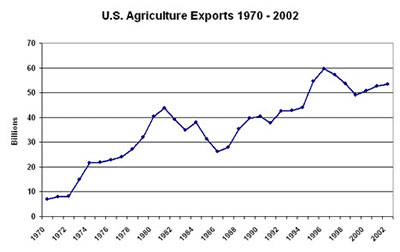
U.S. Agriculture Exports 1970 - 2002
Examine this chart showing the value of U.S. agricultural exports from 1970 to 2002.
Questions
What happened to agricultural exports between 1980 and 1990?
What impact do you think this economic change had on American farmers?
What role do you think government should play if an important sector of the U.S. economy is struggling?
U.S. Census Bureau [online].

Grain Embargo to the Soviet Union - 1979
In December 1979, the Soviet Union invaded Afghanistan. President Carter wanted the Soviet Union to know that they couldn't invade their neighbor without a strong response from the United States. As a result, the United States imposed a grain embargo, refusing to sell the Soviet Union 17 million tons of livestock grain that they had ordered. The embargo on grain was intended to impact the country's source of meat and thus force the Soviet government to reconsider the invasion. However, the Soviet Union was able to get enough grain from other countries, and didn't withdraw from Afghanistan until nearly ten years later. The embargo caused harm to an already struggling U.S. farm economy by removing an export market for American farmers. The grain embargo caused a surplus of grain, resulting in lower prices. In April 1981, soon after taking office, President Ronald Reagan lifted the embargo.
Questions
Should food be used as a weapon in foreign policy? Why or why not?
Robert L. Paarlberg, "Lessons of the Grain Embargo," Foreign Affairs, 1980 [online]; and Clifton B. Luttrell, "The Russian Grain Embargo: Dubious Success," Federal Reserve Bank of St. Louis [online].

High Debt For Farmers
During the 1970s, farmers took advantage of good economic times to expand. They bought more land, more expensive and better machines, and more farming supplies and services. Many farmers paid for the cost of expansion with low-interest loans. Unfortunately, the economy began to change in the late 1970s. Interest rates went up, people became more conservative in their spending habits, which forced prices on farm goods down, and farm debts began to grow. Some farmers hoped to ride out the bad times by getting more loans, but the hard times persisted, and farmers made even less money. Many farmers lost their farms, or had to get second jobs when their farm was not providing enough income to support their families.
Questions
For what purposes did farmers borrow money in the 1970s?
How did the economic downturn of the early 1980s make it difficult or impossible to repay their debt?
What lessons can Americans learn from their experience?

The Agriculture and Food Act of 1981
The Agriculture and Food Act of 1981 (S.884) was constructed by the 97thCongress of the United States (1981-1982). The 1981 farm bill contained 18 sections or titles including:
Title I: Dairy
Title II: Wool and Mohair
Title III: Wheat
Title IV: Feed Grains
Title V: Cotton
Title VI: Rice
Title VII: Peanuts
Title VIII: Soybeans
Title IX: Sugar
Title X: Grain Reserves and National Agricultural Cost of Production Standards Review Board
Title XI: Miscellaneous
Title XII: Agricultural Exports and Public Law 480
Title XIII: Food Stamp and Commodity Distribution Amendments of 1981
Title XIV: National Agricultural Research, Extension, and Teaching Policy Act Amendments of 1981
Title XVI: Credit, Rural Development, and Family Farms
Title XVII: Floral Research and Consumer Information
Title XVIII: Effective Date
Questions
Choose one of the sections/titles within the 1981 farm bill and read through its details within the bill’s summary. Looking at the details of your chosen title, why do you think that the Senate included this section within the law?
What are the positives and the negatives of the changes included within the section?
Who is impacted by these changes (e.g., producers, consumers)?
Looking at what is included in the 1981 farm bill, what might be missing from the law?
What historical events happened during this time period that could impact what is and is not included in the bill?
S.884-Agriculture and Food Act of 1981. (n.d.). Congress.gov.


Many protests broke out around the nation in response to hard times for American agriculture. The Farmers Home Administration placed a two-year moratorium on farm foreclosures in 1983, and many banks held off as long as possible on past due loans in order to assist desperate farmers. Eventually, though, many farmers were forced out of business.
Growing concerns about the effects of agriculture on the environment brought about a merger of crop support payments and resource conservation in the 1985 Farm Bill. This Farm Bill was the first to contain conservation requirements. The new law mandated that farmers implement conservation farming practices in order to receive benefits from USDA.
As a result of the new farm bill, the Department of Agriculture initiated the Conservation Reserve Program to pay landowners to protect environmentally sensitive cropland by planting trees, grass and other ground covers in place of agricultural crops. Additionally, USDA began to put more emphasis on natural resource protection in its research programs. Scientists and engineers provided farmers and other land owners with science-based information and technical assistance to help them manage their land in environmentally sound ways.
Ultimately, expanding trade was seen as the essential solution to ending the agricultural crisis American farmers faced in the 1980s. In order to further fair trade President Reagan agreed to begin a series of trade negotiations in 1986, known as the Uruguay Round. These negotiations lasted from 1986 to 1994 and led to the 1995 creation of the World Trade Organization (WTO), which set rules for trade between nations.
Many protests broke out around the nation in response to hard times for American agriculture. The Farmers Home Administration placed a two-year moratorium on farm foreclosures in 1983, and many banks held off as long as possible on past due loans in order to assist desperate farmers. Eventually, though, many farmers were forced out of business.

The Economy of the 1980s
Read about the economy in the United States during the 1980s from An Outline of the U.S. Economy.
"The nation endured a deep recession throughout 1982. Business bankruptcies rose 50 percent over the previous year. Farmers were especially hard hit, as agricultural exports declined, crop prices fell, and interest rates rose. But while the medicine of a sharp slowdown was hard to swallow, it did break the destructive cycle in which the economy had been caught. By 1983, inflation had eased, the economy had rebounded, and the United States began a sustained period of economic growth. The annual inflation rate remained under 5 percent throughout most of the 1980s and into the 1990s.
"The economic upheaval of the 1970s had important political consequences. The American people expressed their discontent with federal policies by turning out Carter in 1980 and electing former Hollywood actor and California governor Ronald Reagan as president. Reagan (1981-1989) based his economic program on the theory of supply-side economics, which advocated reducing tax rates so people could keep more of what they earned. The theory was that lower tax rates would induce people to work harder and longer, and that this in turn would lead to more saving and investment, resulting in more production and stimulating overall economic growth. While the Reagan-inspired tax cuts served mainly to benefit wealthier Americans, the economic theory behind the cuts argued that benefits would extend to lower-income people as well because higher investment would lead [to] new job opportunities and higher wages.
"The central theme of Reagan's national agenda, however, was his belief that the federal government had become too big and intrusive. In the early 1980s, while he was cutting taxes, Reagan was also slashing social programs. Reagan also undertook a campaign throughout his tenure to reduce or eliminate government regulations affecting the consumer, the workplace, and the environment. At the same time, however, he feared that the United States had neglected its military in the wake of the Vietnam War, so he successfully pushed for big increases in defense spending.
"The combination of tax cuts and higher military spending overwhelmed more modest reductions in spending on domestic programs. As a result, the federal budget deficit swelled even beyond the levels it had reached during the recession of the early 1980s. From $74,000 million in 1980, the federal budget deficit rose to $221,000 million in 1986. It fell back to $150,000 million in 1987, but then started growing again. Some economists worried that heavy spending and borrowing by the federal government would re-ignite inflation, but the Federal Reserve remained vigilant about controlling price increases, moving quickly to raise interest rates any time it seemed a threat. Under Chairman Paul Volcker and his successor, Alan Greenspan, the Federal Reserve retained the central role of economic traffic cop, eclipsing Congress and the president in guiding the nation's economy.
"The recovery that first built up steam in the early 1980s was not without its problems. Farmers, especially those operating small family farms, continued to face challenges in making a living, especially in 1986 and 1988, when the nation's mid-section was hit by serious droughts, and several years later when it suffered extensive flooding. Some banks faltered from a combination of tight money and unwise lending practices, particularly those known as savings and loan associations, which went on a spree of unwise lending after they were partially deregulat ed. The federal government had to close many of these institutions and pay off their depositors, at enormous cost to taxpayers."
Questions
What ideas formed the basis of President Ronald Reagan's economic theory known as "Reaganomics?"
How well did his economic policies work? What impact did they have on agriculture?
"The U.S. Economy: A Brief History," An Outline of the U.S. Economy, U.S. Information Agency [online].

FARM AID Organization
On September 22, 1985 in Champaign, Illinois, musicians Willie Nelson, Neil Young, and John Mellencamp organized the first FARM AID concert. The concert helped raise money for farmers who were threatened with losing their family farms. Some of the other singers and musicians who performed at the concert were Bob Dylan, Billy Joel, B. B. King, Loretta Lynn, Roy Orbison, and Tom Petty. Visit the website of the FARM AID organization to learn more about their history and mission.
Questions
Why were these singers and musicians so concerned about the plight of small family farms in the 1980s?
What has happened to the FARM AID concerts?
Do you agree or disagree with this organization's cause? Why or why not?

Changing Farm Credit Policies
Read about how the Congress directed the Farmers Home Administration to modify its credit policies for farmers during the 1980s.
"Congress established the Farmers Home Administration (FmHA) in response to the economic impact of the Great Depression of the 1930s. Both the Farm Credit System (FCS) and FmHA have played major roles in supplementing agricultural credit provided by private lenders such as commercial banks and life insurance companies by providing credit to enable producers to purchase farmland as well as to finance annual production expenses. The two lenders play different roles. The Farm Credit System provides credit to creditworthy borrowers. Farmers Home Administration makes financial assistance available primarily to family farmers unable to secure credit from private lenders."
Furthermore:
"When the farm economy deteriorated in the early and mid-1980's, it became apparent that a significant portion of FmHA's loan portfolio would not be repaid by delinquent borrowers and that increased Congressional appropriations in the future would be needed to address shortfalls.
"In 1987, Congress addressed the deteriorating financial position of farm lending organizations across the country in two acts: the Agricultural Credit Act of 1987 (ACA), a supplemental appropriations act. Congress directed FmHA to reinstate the 'continuation policy' which allows borrowers to obtain additional credit without having to show an ability to repay prior loans. FmHA's loan servicing process traditionally included rescheduling, reamortization, and deferrals. The ACA liberalized this, authorizing FmHA to write-down delinquent loans to allow borrowers to continue operating their farms whenever possible. The Food, Agriculture, Conservation and Trade Act of 1990 (FACTA) limited post-November 28, 1990 debt write-down to a lifetime amount of $300,000. In addition, a loan cannot be written down to the point that the net present value of the reduced loan is less than the net recovery value of the loan (prior to restructuring) if liquidated through foreclosure. When no way can be found to restructure a loan through loan servicing and property is foreclosed on by FmHA or voluntarily conveyed to it, the former owner has the first opportunity to lease or repurchase the property, more often than not with Federal financing."
Questions
What reasons would the government have for providing loans to farmers who could not obtain credit from commercial sources?
Why would the government direct the Farmers Home Administration to be lenient on farmers who could not repay their debts during the 1980s?
"Crisis and Activism: 1929-1940," U.S. Senate Committee on Agriculture, Nutrition, and Forestry, 1825-1998 [online]; and "Agricultural Programs," The Impact of Federal Programs on Wetlands: A Report to Congress by the Secretary of the Interior, 1994 [onli
Growing concerns about the effects of agriculture on the environment brought about a merger of crop support payments and resource conservation in the 1985 Farm Bill. This farm bill was the first to contain conservation requirements. The new law mandated that farmers implement conservation farming practices in order to receive benefits from USDA. As a result of the new farm bill, the Department of Agriculture initiated the Conservation Reserve Program to pay landowners to protect environmentally sensitive cropland by planting trees, grass and other ground covers in place of agricultural crops. Additionally, USDA began to put more emphasis on natural resource protection in its research programs. Scientists and engineers provided farmers and other land owners with science-based information and technical assistance to help them manage their land in environmentally sound ways.

Food and Security Act of 1985
The Food and Security Act of 1985 was created and passed into law by the 99th Congress (1985-1986). This farm bill was introduced by Representative E. de la Garza (D-TX-15) in the House Committee Agriculture, Merchant Marine and Fisheries. The bill was signed into law on December 23, 1985. The 1985 farm bill has 18 titles including:
Title I: Dairy
Title II: Wool and Mohair
Title III: Wheat
Title IV: Feed Grains
Title V: Cotton
Title VI: Rice
Title VII: Peanuts
Title VIII: Soybeans
Title IX: Sugar
Title X: General Commodity Provisions
Title XI: Trade
Title XII: Conservation
Title XIII: Credit
Title XIV: Agricultural Research, Extension, and Teaching
Title XV: Food Stamp and Related Provisions
Title XVI: Marketing
Title XVII: Related and Miscellaneous Matters
Title XVIII: General Effective Date
Questions
Choose one of the sections/titles within the 1985 farm bill and read through its details within the 1985 Farm Bill summary. Looking at the details of your chosen title, why do you think that the Senate included this section within the law?
What are the positives and the negatives of the changes included within the section of the farm bill that you explored?
Who is impacted by these changes (e.g., producers, consumers) that you read about?
Looking at what is included in the 1985 farm bill, what might be missing from the law?
What historical events happened during this time period that could have impacted what is and is not included in this farm bill?
How does the 1985 farm bill compare to the 1981 farm bill (found as a sub-event under “Low Land Values and High Debt”)?
Are there things that were included in the 1981 law that are/are not included in the 1985 farm bill?
Why might these similarities and differences exist within the 1981 and 1985 farm bills?
H.R.2100-Food Security Act of 1985. (n.d.). Congress.gov.

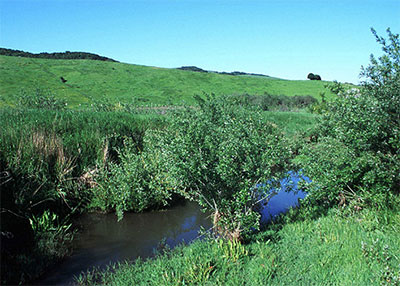
Conservation Reserve Program
"Originally authorized under the 1985 Farm Bill, [the Conservation Reserve Program (CRP)] is a voluntary program sponsored by USDA that provides incentives to landowners to remove environmentally sensitive land from agricultural production and instead establish protective vegetative cover of grass, trees, or wildlife habitat. Since its inception in 1986, this program has helped reduce soil erosion by more than 40 percent and restored 1.8 million acres of critical wetlands. Since President Bush signed the historic 2002 Farm Bill, CRP has increased enrollment by 2.6 million acres, conserving a total of 34.8 million acres of environmentally sensitive land for wildlife habitat, riparian buffers, and soil protection. The 2002 Farm Bill provides more than $40 billion over a decade to restore millions of acres of wetlands, protect habitats, conserve water, and improve streams and rivers near working farms and ranches."
Questions
Why would the government be willing to pay farmers money to participate in the Conservation Reserve Program?
How can this program change life in America?
Why would a farmer want to participate in the program? Why not?
"Conservation Initiatives Fact Sheet," White House [online].

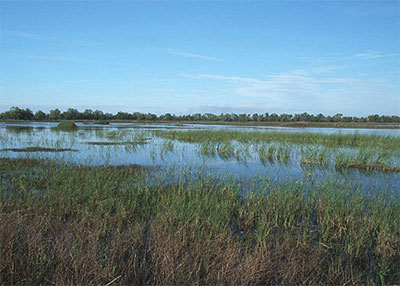
Agricultural Research Service
Natural resources and sustainable agricultural systems are a major program area for the USDA's Agricultural Research Service. Many career scientists around the country work on projects in this program area.
Questions
Why would the U.S. Department of Agriculture be responsible for doing conservation research?
How does American agriculture benefit from research on natural resources?
How do farmers benefit from the Agricultural Research Service?
How does the American public benefit from the Agricultural Research Service?
Ultimately, expanding trade was seen as the essential solution to ending the agricultural crisis American farmers faced in the 1980s. In order to further fair trade President Reagan agreed to begin a series of trade negotiations in 1986, known as the Uruguay Round. These negotiations lasted from 1986 to 1994 and led to the 1995 creation of the World Trade Organization (WTO), which set rules for trade between nations.

World Trade Organizations
The World Trade Organization (WTO) develops the rules for trade between nations. Visit the WTO In Brief web page to learn about the WTO. Explore some of the links on this page to examine the organization's history and its mission.
Questions
How might membership in the WTO benefit American agriculture?
How might it cause problems for agriculture in the United States?
What concerns might some Americans have regarding our nation's membership in the WTO?


The farm crisis of the 1980s also led more farmers away from traditional crop production and toward growing alternative or high-value crops that were becoming increasingly popular with consumers. These included: commercially growing herbs and wildflowers; fish-farming by raising fish like catfish, crayfish and freshwater shrimp; and organic farming which avoids or largely excludes the use of synthetically compounded fertilizers, pesticides, growth regulators, and livestock feed additives in agricultural production.
Many farmers during this period also began to consider a wholly different approach to agriculture called sustainable agriculture, or a system of farming that maintained its productivity and usefulness to people forever. Sustainable agriculture was seen as being achievable by adopting methods of farming that conserved natural and farm resources, protected the environment, enhanced people's quality of life, and allowed farmers to stay economically competitive.
In 1988, the USDA started the Sustainable Agriculture Research and Education program (or SARE) as part of its Cooperative State Research, Education, and Extension Service. This program funded projects and conducted outreach to improve agricultural systems and to help advance farming systems that were profitable, environmentally sound and good for communities.
The farm crisis of the 1980s also led more farmers away from traditional crop production and toward growing alternative or high-value crops that were becoming increasingly popular with consumers. These included: commercially growing herbs and wildflowers; fish-farming by raising fish like catfish, crayfish and freshwater shrimp; and organic farming which avoids or largely excludes the use of synthetically compounded fertilizers, pesticides, growth regulators, and livestock feed additives in agricultural production.


Karl Kupers' Farming
"Karl Kupers, an eastern Washington grain grower, was a typical dryland wheat farmer who idled his land in fallow to conserve moisture. After years of watching his soil blow away and his market price slip, he made drastic changes to his 5,600-acre operation. In place of fallow, he planted more profitable hard red and hard white wheats along with seed crops like condiment mustard, sunflower, grass and safflower. All of those were drilled using a no-till system Kupers calls direct-seeding.
"'I look at this more diverse system as a tremendous opportunity to decrease chemical use and make more net profit per acre,' said Kupers, who received a grant from USDA's Sustainable Agriculture Research and Education (SARE) program to offset the risk. Now, he puts his exuberant personality to work as an aggressive marketer of alternative crops--clearing more profits each year while achieving his goal to save soil.
"'Economically, I think we're just about at that point where we can show that we can be sustainable for the short term and the future,' he said. 'We put no dust in the atmosphere, there's no particulate matter, if water does run off our soils, it is clean water.'
"Although growing alternative crops to diversify a traditional farm rotation increase[s] profits while lessening adverse environmental impacts, the majority of U.S. cropland is still planted in just three crops: soybeans, corn and wheat. That lack of crop diversity can cause problems for farmers, from low profits to soil erosion. Adding new crops that fit climate, geography and management preferences can improve not only your bottom line, but also your whole farming outlook.
"'Continued low commodity prices have gradually driven more and more people to look for other options,' said Rob Myers, executive director of the Thomas Jefferson Agricultural Institute in Columbia, Mo. For some farmers, planting alternative crops has made an 'immediate and significant' improvement in income, he said.
"Kupers is not the only farmer who diversified his monoculture cropping system to enjoy renewed profits. Members of the Northwest Kansas Farm Management Association, for example, enjoyed average net farm incomes of $50,485 in 1998--three times that of other Kansas growers--after diversifying their operations."
Questions
Why did Karl Kupers' diversify his farming operation?
What benefits did Kupers achieve by planting alternative crops?
How did the government help Mr. Kupers with his efforts to diversify his farm?
Do you agree or disagree with the government's efforts to support this farmer? Why or why not?
"Diversifying Cropping Systems," Opportunities in Agriculture Bulletin, Sustainable Agriculture Research and Education, U.S. Department of Agriculture [online].

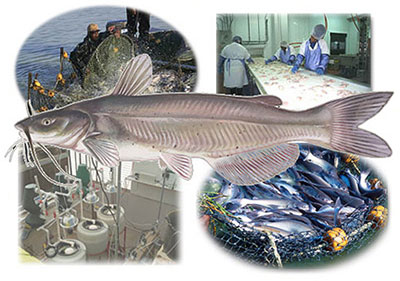
Catfish Farming
"Catfish farming makes up a large percentage of the U.S. aquaculture industry and typifies aquaculture in action. The life of a farm-raised catfish begins with the mating of genetically bred broodstock. Broodstock are sexually mature fish used solely for reproduction. They are so important that some farmers specialize in their production.
"Typically, once the eggs are laid and fertilized, they are placed in controlled hatching tanks with oxygenated water of suitable temperature and quality. The eggs hatch in seven to eight days, and 18 days after hatching the young catfish--'fry,' as they are called--are strong enough to be transferred to outdoor ponds to mature.
"The pond size may vary from 5 to 20 acres, is 4 to 5 feet deep, and is usually fed by a good supply of well water. Catfish fry, which are less than 1 inch long at this point, are stocked at densities ranging from 70,000 per acre to upwards of 200,000 per acre, as recommended by hatchery biologists.
"Once fish enter the pond, their growth and survival will wholly depend upon the quality of that environment. Everything the fish comes into contact with has the potential of becoming a part of the edible flesh of that organism and can affect its life. If the water or food contains contaminants, they may end up in the fish. If improper drugs are used to treat a disease, residues of those drugs may also become a part of the fish. If too many aquatic plants are present, they will compete with the fish for oxygen. Sound management is essential to keep the fish growing.
"So, from the time of stocking to the time of harvest, the farmer is busy controlling the aquaculture system.
"First, every attention is given to the quality of the commercially prepared dry pellet diet. It must be high in protein, made of soybeans, corn, wheat, and fishmeal, and contain a balance of essential vitamins and minerals.
"A balanced diet of floating pellets is mechanically scattered on the fish pond's surface once or twice daily. Fish gourmets credit the pellet for the catfish's distinctive flavor, which they say they would recognize blindfolded. Others say the taste comes from the sweet well water in which the catfish grow. This, too, is managed by the farmer.
"Even before the fish go into the pond, water quality and location are concerns. The farmers make sure the pond's soil is free of pesticides and not contaminated. Then they secure an abundant source of clean water. Most catfish farmers use well water because of its desirable chemical makeup and lack of contaminants.
"The water quality must be constantly checked for optimum growth requirements: proper temperature, the right amount of oxygen, the appropriate water chemistry, and just the right balance of aquatic plants and weeds.
"Under the best conditions, 18 to 24 months after hatching, the catfish reach a market weight size of one and one-quarter to one and one-half pounds. They are transferred from the pond to water-laden, oxygen-treated tank trucks for live shipment to the processing plant."
Questions
How does fish farming compare to growing traditional agricultural products?
What are the advantages? What are the disadvantages?
Beverly Corey, "Life on a Fish Farm: Food Safety a Priority," U.S. Food and Drug Administration [online].


John Vollmer's Organic Strawberries
"When John Vollmer, a third-generation tobacco farmer in Bunn, N.C., decided to stop growing tobacco and start raising strawberries organically, it was an unexpected move for someone who describes himself as a chemical-oriented farmer. Yet, Vollmer, whose main priority was finding a way to keep the family farm in the family, recognized that organic production might be a route to greater profits.
"'It was not an easy transition for me to think in other ways,' said Vollmer, a former agricultural chemical salesman. Yet, as he read books on organic soil management, he soon found himself fascinated by organic farming concepts. Over the next two years, he built soil organic matter with composts and cover crops and carefully researched organic techniques. Then he began his transition.
"Since then, his two acres of organic strawberries have been so successful that Vollmer brought another 25 acres into mixed fruit and vegetable production using the same soil and pest management techniques. While he has not certified that new acreage because he still wants to apply agri-chemical sprays if needed, he now considers himself more organic than conventional in the new field. In fact, asked whether he has any doubts about organic farming, Vollmer replied that he has only one: whether he should be transitioning those 25 acres now--or later.
"Vollmer typifies the enormous changes that have occurred in organic farming over the last 20 years. Two decades ago, it would have been impossible to predict the huge expansion of the organic industry."
Questions
How long did it take John Vollmer to prepare his farm to become an organic agricultural operation?
What steps did he go through to make the transition?
How successful did he feel his efforts were?
"Transitioning to Organic Production," Opportunities in Agriculture Bulletin, Sustainable Agriculture Research and Education, U.S. Department of Agriculture [online].
Many farmers during this period also began to consider a wholly different approach to agriculture called sustainable agriculture, or a system of farming that maintained its productivity and usefulness to people forever. Sustainable agriculture was seen as being achievable by adopting methods of farming that conserved natural and farm resources, protected the environment, enhanced people’s quality of life, and allowed farmers to stay economically competitive.

Exploring Sustainability in Agriculture
Read the booklet Exploring Sustainability in Agriculture at the Sustainable Agriculture Research and Education Service website, and then answer the following questions.
Questions
What makes sustainable agriculture different from conventional agriculture?
How many different ways are there to practice sustainable agriculture?
How would you define the basic principles of sustainable agriculture?
In your opinion, how will this approach to agriculture change our nation and the world?

Sustainable Agriculture Research and Education
As an alternative to competing with large farms, many small farm owners are now marketing specialty products directly to consumers through Community Supported Agriculture (CSA). Visit the Sustainable Agriculture Research and Education website to learn about CSA farms. Find a CSA farm near you.
Questions
Why are there more CSA farms in some states than in others?
What advantages do farmers with this kind of marketing approach enjoy? What might be the limitations?
Besides providing Americans with an alternative source of food, what other benefits could there be?


During the 1990s farm management became increasingly important. Because the cost of inputs (the things a farmer needs to produce a crop) rose sharply during the 1980s, farmers needed to become better business managers and computer users in order to succeed.
In response to these problems USDA scientists and their university partners worked to help farmers reduce their production costs and increase their efficiency. For example, precision agriculture and the use of computers were introduced during this decade as a way to manage smaller areas within fields instead of managing whole fields. By using site-specific information and global positioning satellites, or GPS, farmers could more efficiently manage pests, nutrients, seeding rates, water and other resources.
Another innovation that became widely practiced by farmers during these years was conservation tillage systems. These systems involved leaving leftover crop stalks on the soil surface, mainly to control erosion. This practice resulted in greater water conservation and reduced run-off into streams and lakes, which better protected the environment.
This decade also saw an increased concern for preserving and protecting America's irreplaceable farmland - land that has been farmed for generations and that is essential for producing our food and providing us with scenic open space, wildlife habitat and clean water. To stop the losses of this vital resource both private and government groups were founded to protect land that was becoming increasingly at risk from urban sprawl and rural subdivisions.
During the 1990s farm management became increasingly important. Because the cost of inputs (the things a farmer needs to produce a crop) rose sharply during the 1980s, farmers needed to become better business managers and computer users in order to succeed.

Using Computers to Farm
Successful farming requires "smart" work. Read this article about farmers and their use of computers at the Journal of Extension and answer the following questions.
What Influences Farmers' Computer Use?
Questions
Why did the author of the article write that farmers must farm "smarter?"
How did computers help farmers be more successful?
In response to these problems USDA scientists and their university partners worked to help farmers reduce their production costs and increase their efficiency. For example, precision agriculture and the use of computers were introduced during this decade as a way to manage smaller areas within fields instead of managing whole fields. By using site-specific information and global positioning satellites, or GPS, farmers could more efficiently manage pests, nutrients, seeding rates, water and other resources.


GPS
These northern Louisiana farmers are using global positioning technology to make precise applications of fertilizers, pesticides, and herbicides where they are needed on small areas of the field.
Questions
How might using computers and global positioning satellites benefit these farmers?
How difficult would it be to make precise applications of fertilizers, pesticides, and herbicides to small areas of a field without the aid of computers and other information technologies?


GPS History
"The Global Positioning System (GPS) is a space-based radio-navigation system consisting of a constellation of satellites and a network of ground stations used for monitoring and control. A minimum of 24 GPS satellites orbit the Earth at an altitude of approximately 11,000 miles providing users with accurate information on position, velocity, and time anywhere in the world and in all weather conditions.
"GPS is operated and maintained by the Department of Defense (DoD). The Interagency GPS Executive Board (IGEB) manages GPS, while the U.S. Coast Guard acts as the civil interface to the public for GPS matters. The Federal Aviation Administration is investigating and applying the use of GPS as it pertains to aviation.
History and Development
"GPS, formally known as the Navstar Global Positioning System, was initiated in 1973 to reduce the proliferation of navigation aids. By creating a system that overcame the limitations of many existing navigation systems, GPS became attractive to a broad spectrum of users worldwide. GPS has been successful in virtually all navigation applications, and because its capabilities are accessible using small, inexpensive equipment, GPS is being utilized in a wide variety of applications across the globe."
Questions
What areas of your life does the GPS impact?
In what ways would a farmer benefit from the GPS?
"GPS Basics," Satellite Navigation Product Teams, Federal Aviation Administration [online].
Another innovation that became widely practiced by farmers during these years was conservation tillage systems. These systems involved leaving leftover crop stalks on the soil surface, mainly to control erosion. This practice resulted in greater water conservation and reduced run-off into streams and lakes, which better protected the environment.

Plants Database
The Plants Database is part of the USDA's Natural Resource Conservation Service. According to the USDA, the database contains "standardized information about the vascular plants, mosses, liverworts, hornworts, and lichens of the U.S. and its territories." Visit the database website and type in the common name of a plant in your part of the country.
Questions
Is the plant you typed in native to the United States? In what states is the plant found? What is its scientific name?
Why would collecting all the plant information for the United States be part of the mission of the USDA's Natural Resource Conservation Service? How can farmers and ranchers make use of this information?
How can Americans with backyards or rooftop and community gardens make use of this information?

Extension Services
"All universities engage in research and teaching, but the nation's more than 100 land-grant colleges and universities have a third critical mission--extension. 'Extension' means 'reaching out,' and--along with teaching and research--land-grant institutions 'extend' their resources, solving public needs with college or university resources through non-formal, non-credit programs.
"Congress created the extension system nearly a century ago to address exclusively rural, agricultural issues. At that time, more than 50 percent of the U.S. population lived in rural areas, and 30 percent of the workforce was engaged in farming. Extension's engagement with rural America helped make possible the American agricultural revolution, which dramatically increased farm productivity:
--In 1945, it took up to 14 labor-hours to produce 100 bushels of corn on 2 acres of land.
--By 1987, it took just under 3 labor-hours to produce that same 100 bushels of corn on just over 1 acre.
--In 2002, that same 100 bushels of corn were produced on less than 1 acre.
"That increase in productivity has allowed fewer farmers to produce more food.
"Fewer than 2 percent of Americans farm for a living today, and only 10 percent of Americans now live in rural areas. Yet, the extension service still plays an important role in American life--rural, urban, and suburban. With its unprecedented reach--with an office in or near most of the nation's approximately 3,000 counties--extension agents help farmers grow crops, homeowners plan and maintain their homes, and children learn skills to become tomorrow's leaders."
Questions
How does the USDA and its land-grant extension partners work together to help farmers?
Why does the government work with universities to do this work?
Who benefits from extension services besides farmers?
"Extension: Introduction," Cooperative State Research, Education, and Extension Service, U.S. Department of Agriculture [online].


The world underwent dramatic changes during the 1990s. The Berlin Wall that had stood for twenty-eight years as a symbol of the Cold War came down in May 1989; and by December 1991 the Soviet Union was no more.
The economy of the 1990s was one of rapid growth highlighted by a stock market boom that was fueled by emerging Internet businesses. Inflation and unemployment were at historic lows. This economic boom was enhanced by instantaneous telecommunications and new information technologies.
Innovative information technologies opened up vast new frontiers for science. The Human Genome project identified approximately thirty thousand genes in human DNA and made this information publicly available to scientists everywhere. Similar genome projects were started for farm animals, plants and microorganisms. In 1996 Dolly the sheep, the first cloned farm animal, was born. Government and private investment helped launch a multi-billion dollar biotechnology industry to develop new medical and agricultural applications.
Conditions for farmers also improved during the 1990s. Low interest rates meant that farmers had less debt. In 1992 President George H. W. Bush signed the North American Free Trade Agreement (or NAFTA) between the United States, Canada, and Mexico, which eliminated trade barriers and facilitated trade among the three countries. NAFTA resulted in a dramatic rise in food exports to Canada and Mexico. Export levels of U.S. agricultural goods reached new highs in the mid-1990s.
During the 1990s two farm bills were signed into law. Under President George H. W. Bush, the Food, Agriculture, Conservation, and Trade Act of 1990 was signed into law. Under President Bill Clinton, the Federal Agriculture Improvement and Reform Act of 1996 was signed into law.

Food, Agriculture, Conservation, and Trade Act of 1990
According to the summary found on govtrack:
“The Food, Agriculture, Conservation, and Trade (FACT) Act of 1990—P.L. 101-624 (November 28, 1990) was a 5-year omnibus farm bill that passed Congress and was signed into law. This bill, also known as the 1990 farm bill, continued to move agriculture in a market-oriented direction by freezing target prices and allowing more planting flexibility.”
Questions
What events were going on during this time period that could have impacted the government’s decision to freeze target prices and allowing more planting flexibility?
Why might the events of this time period have impacted the decisions for this farm bill?
S. 2830 (101st): Food, Agriculture, Conservation, and Trade Act of 1990. (2018). govtrack.

Federal Agriculture Improvement and Reform Act of 1996
The Federal Agriculture Improvement and Reform Act of 1996 was signed into law on April 4, 1996 by President Clinton (Public Law 104-127;7). Unlike other farm bills that covered two to five years, this farm bill created a seven-year plan for the Secretary of Agriculture to oversee agriculture and food programs from 1996-2002. Commodity programs were one thing that was impacted by the 1996 farm bill including direct payment programs for crops, elimination of most supply controls, elimination of milk price supports through direct government purchases of dairy products, and the consolidation of milk marketing orders used to administer a nationwide system of classified pricing for milk.
According to Nelson and Schertz (n.d.), “Other provisions of the 1996 Act extend, modify, and establish various priorities, procedures, and options for administering programs related to commodities, nutrition, rural development, conservation, farm credit, agricultural trade, research, and generic commodity promotion.”
Questions
Why might the 1996 farm bill create guidelines and provisions for seven years rather than two to five years as previous farm bills?
Of the list of issues covered in the 1996 farm bill including commodities, nutrition, rural development, conservation, farm credit, agricultural trade, research, and generic commodity promotion, which of these issues do you think would most impact agricultural production and consumption?
Why do you think your chosen issue is the most important?
Nelson, F. J. & Schertz, L. P. (n.d.). Provisions of the Federal Agriculture Improvement and Reform Act of 1996.
The economy of the 1990s was one of rapid growth highlighted by a stock market boom that was fueled by emerging Internet businesses. Inflation and unemployment were at historic lows. This economic boom was enhanced by instantaneous telecommunications and new information technologies.
Conditions for farmers also improved during the 1990s. Low interest rates meant farmers had less debt. In 1992 President George H. W. Bush signed the North American Free Trade Agreement (or NAFTA) between the United States, and Canada and Mexico, which eliminated trade barriers and facilitated trade among the three countries. NAFTA resulted in a dramatic rise in food exports to Canada and Mexico. Export levels of U.S. agricultural goods reached new highs in the mid-1990s.

NAFTA
"The North American Free Trade Agreement (NAFTA), which took effect on January 1, 1994, called for the phasing out of virtually all restrictions on trade and investment flows among the United States, Canada, and Mexico over 10 years (with a few of the most sensitive restrictions eliminated over 15 years). The United States and Canada were already well into the elimination of the barriers between themselves in accordance with the Canada-United States Free Trade Agreement, so the main new feature of NAFTA was the removal of the barriers between Mexico and those two countries."
North American Free Trade Agreement
Questions
Why did the United States enter into this agreement with Canada and Mexico?
What benefits does NAFTA provide to each of the three countries?
Do you think that NAFTA is a good idea? Why or why not?
The Effects of NAFTA on U.S. Mexican Trade and GDP, Congressional Business Office [online].

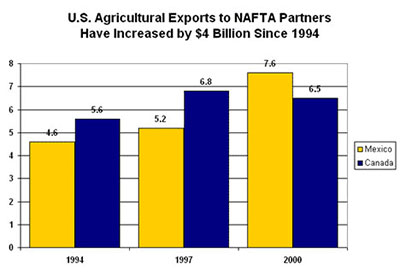
Exports to NAFTA Partners
Some Positive Stories from NAFTA
"U.S. pork producers credit NAFTA with their gains in market share in Mexico for pork products[,] which increased 130 percent between 1994 and 2000.
"The volume of U.S. beef and veal exports to Canada increased 26 percent between 1990 and 2000 and increased over fivefold to Mexico during 1993 to 2000.
"Sales of U.S. corn to Canada increased more than 127 percent in volume between 1990 and 2000 and increased nearly eighteen fold to Mexico during 1993 to 2000. Mexico chose to expedite its market openings for corn under NAFTA in order to provide lower cost food to its increasingly urban population and to ensure it had sufficient animal feed. The volume of U.S. soybean exports to Canada increased 15 percent between 1990 and 2000 and doubled for Mexico during 1993 to 2000.
"Exports of U.S. horticultural products to Canada have increased almost 30 percent since 1994, reaching $3.3 billion in 2000."
Questions
Why have agricultural exports increased since NAFTA took effect?
What effect would these increases have on American farmers?
Why do you think some people are against NAFTA?
"Benefits of NAFTA," FAS Backgrounder, Foreign Agricultural Service, U.S. Department of Agriculture [online].
The Human Genome Project identified approximately thirty thousand genes in human DNA and made this information publicly available to scientists everywhere. Similar genome projects were started for farm animals, plants and microorganisms. In 1996 Dolly the sheep, the first cloned farm animal, was born. Government and private investment helped launch a multi-billion dollar biotechnology industry to develop new medical and agricultural applications.

Why Clone?
Based on the Genetic Science Learning Center from the University of Utah, there are many reasons for cloning in animals and medicine.
Dolly the Sheep, the most well-known animal cloned from an adult cell, lived for only six years, half that of the life span of a normal sheep. Of thirteen cloned sheep, none, including those that have been from the same cell line as Dolly, experienced any long-term health effects from cloning.
Consider the information presented on the website below and answer the related questions.
Questions
What are the ways in which cloning might be useful?
How might cloning be used in medicine?
What questions does this information raise?

Human Genome Project
Since 1947, the Department of Energy (DOE) and its predecessor agencies have been charged by Congress with developing new energy resources and technologies and pursuing a deeper understanding of the potential health and environmental risks posed by their production and use. Such studies, for example, have provided the scientific basis for individual risk assessments of nuclear medicine technologies. Visit the Human Genome Project website sponsored by the DOE and answer the following questions.
Questions
Why is the Department of Energy tasked by Congress to study human genomes?
What is the value of this research?


After a series of highly publicized food related deaths caused by unpasteurized fruit juice and undercooked fast food hamburgers during the mid-1990s, there was a public outcry for more food safety regulation. In January 1997, President Bill Clinton launched the President's Food Safety Initiative to promote public health and improve food safety.
Following this initiative, the USDA took steps to improve food safety from the farm to the table. Scientists developed methods to reduce levels of bacterial contamination on livestock and rapid tests to identify germs in food. Research proved that irradiation was safe and effective, although expensive, for decreasing or eliminating harmful bacteria in meat, poultry and other foods (including fresh fruits, vegetables, and spices).
As the public demand for high quality and safe foods increased, many small farmers found success by aggressively marketing their organic and specialty products to consumers.
Meanwhile, large agribusinesses began contracting with farmers and ranchers to raise products that specifically met their needs and standards. This system, called vertical integration, allowed food companies to control the quantity, quality, and price of their foods from farm to fork.
By the end of the 1990s it was clear that farming had changed. Farms were larger but fewer in number, and both small and large farms were more specialized and more efficient.
After a series of highly publicized food related deaths caused by unpasteurized fruit juice and undercooked fast food hamburgers during the mid-1990s, there was a public outcry for more food safety regulation. In January 1997, President Bill Clinton launched the President’s Food Safety Initiative to promote public health and improve food safety. Following this initiative, the USDA took steps to improve food safety from the farm to the table. Scientists developed methods to reduce levels of bacterial contamination on livestock and rapid tests to identify germs in food. Research proved that irradiation was safe and effective, although expensive, for decreasing or eliminating harmful bacteria in meat, poultry and other foods (including fresh fruits, vegetables, and spices).

Food Safety
In his January 25, 1997 radio address, President Bill Clinton said the following:
"We have built a solid foundation for the health of America's families. But clearly we must do more. No parent should have to think twice about the juice they pour their children at breakfast, or a hamburger ordered during dinner out."
Questions
How do you feel about the safety of the food you eat each day?
Why was the President concerned about the safety of America's food supply?
"Food Safety Initiative Fact Sheet," FoodSafety.gov [online].

Bill Clinton
Bill Clinton was the first Democratic President since Franklin D. Roosevelt to win a second term. Visit the White House website to read a brief biography of this very popular President and answer the following questions.
President Bill Clinton history
Questions
Why was President Clinton so popular?
Why did he eventually become only the second President to be impeached?
As the public demand for high quality and safe foods increased, many small farmers found success by aggressively marketing their organic and specialty products to consumers. Meanwhile, large agribusinesses began contracting with farmers and ranchers to raise products that specifically met their needs and standards. This system, called vertical integration, allowed food companies to control the quantity, quality, and price of their foods from farm to fork. By the end of the 1990s it was clear that farming had changed. Farms were larger but fewer in number, and both small and large farms were more specialized and more efficient.


Organic Food
"The U.S. Department of Agriculture has put in place a set of national standards that food labeled 'organic' must meet, whether it is grown in the United States or imported from other countries. After October 21, 2002, when you buy food labeled 'organic,' you can be sure that it was produced using the highest organic production and handling standards in the world.
"What is organic food?
Organic food is produced by farmers who emphasize the use of renewable resources and the conservation of soil and water to enhance environmental quality for future generations. Organic meat, poultry, eggs, and dairy products come from animals that are given no antibiotics or growth hormones. Organic food is produced without using most conventional pesticides fertilizers made with synthetic ingredients or sewage sludge bioengineering or ionizing radiation. Before a product can be labeled 'organic,' a Government-approved certifier inspects the farm where the food is grown to make sure the farmer is following all the rules necessary to meet USDA organic standards. Companies that handle or process organic food before it gets to your local supermarket or restaurant must be certified, too.
"Is organic food better for me and my family?
USDA makes no claims that organically produced food is safer or more nutritious than conventionally produced food. Organic food differs from conventionally produced food in the way it is grown, handled, and processed.
"When I go to the supermarket, how can I tell organically produced food from conventionally produced food?
You must look at package labels and watch for signs in the supermarket. Along with the national organic standards, USDA developed strict labeling rules to help consumers know the exact organic content of the food they buy. The USDA Organic seal also tells you that a product is at least 95 percent organic.
"Single-ingredient foods
Look for the word 'organic' and a small sticker version of the USDA Organic seal on vegetables or pieces of fruit. Or they may appear on the sign above the organic produce display.
"The word 'organic' and the seal may also appear on packages of meat, cartons of milk or eggs, cheese, and other single-ingredient foods.
"Foods with more than one ingredient
"The above photo shows examples of the labels that may be used on a wide variety of products that use organic ingredients.
"The sample cereal boxes show the four labeling categories. From left: cereal with 100 percent organic ingredients[,] cereal with 95-100 percent organic ingredients[,] cereal made with at least 70 percent organic ingredients[,] and cereal with less than 70 percent organic ingredients. Products with less than 70 percent organic ingredients may list specific organically produced ingredients on the side panel of the package, but may not make any organic claims on the front of the package. Look for the name and address of the Government-approved certifier on all packaged products that contain at least 70 percent organic ingredients.
"Will I find the USDA Organic seal on all 100 percent organic products, or products with at least 95 percent organic ingredients?
No. The use of the seal is voluntary.
"How is use of the USDA Organic seal protected?
People who sell or label a product 'organic' when they know it does not meet USDA standards can be fined up to $10,000 for each violation.
"Does natural mean organic?
No. Natural and organic are not interchangeable. Other truthful claims, such as free-range, hormone-free, and natural, can still appear on food labels. However, don't confuse these terms with 'organic.' Only food labeled 'organic' has been certified as meeting USDA organic standards."
Questions
Do you or your family use organically grown foods? Why or why not?
How important is the supply of organically grown foods to you?
"Organic Food Standards and Labels: The Facts," Agricultural Marketing Service, U.S. Department of Agriculture [online].

Vertical Integration
Vertical integration exists when a company owns all the different aspects of making, selling, and delivering a product or service. In the oil industry, for example, this refers to major oil companies that have ownership or control of the drilling, pumping, refining, and distribution of petroleum products.
Questions
How do you think vertical integration is used in agriculture?
Who benefits from vertical integration in agriculture?

Copied url to clipboard!



